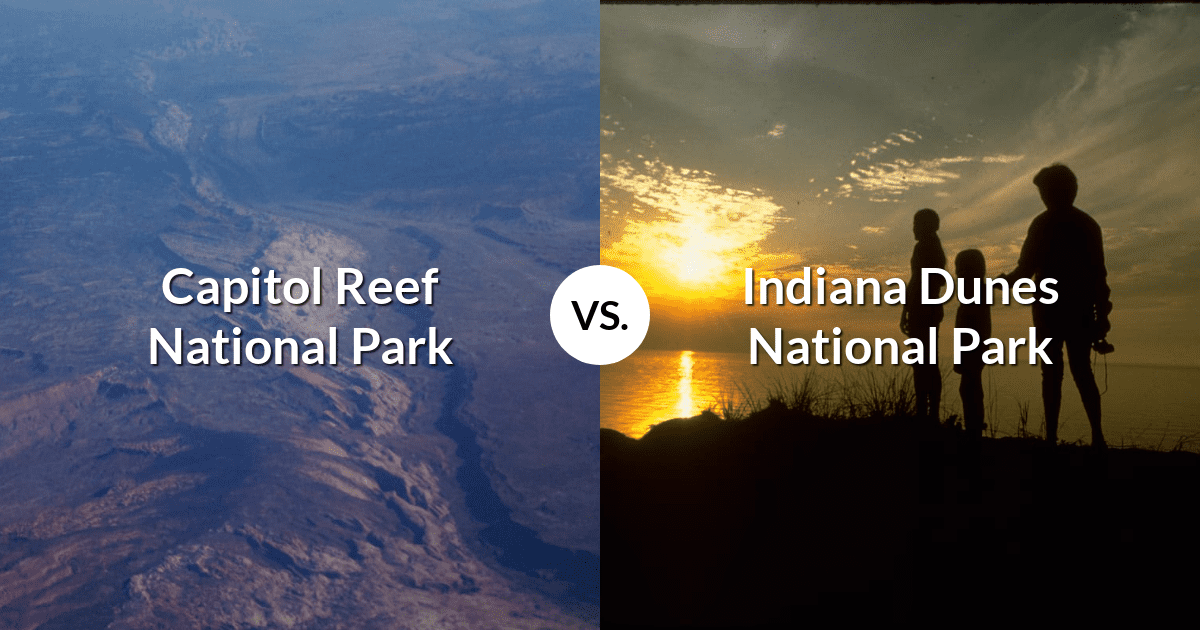Jake Cain is an entrepreneur and writer from Cincinnati, Ohio. He spends his free time driving around the country in his late 90’s conversion van, affectionately known as the “Monster Van” with his wife and 3 boys.

Capitol Reef National Park and Indiana Dunes National Park offer vastly different landscapes and experiences for visitors. On one hand, Capitol Reef National Park is a rugged and remote desert wilderness, dotted with towering rock formations and winding canyons. On the other hand, Indiana Dunes National Park is a lush and lively coastal haven, complete with sandy beaches, dunes, and wetlands. Both parks offer unique opportunities for adventure, exploration, and relaxation, making them must-visit destinations for nature lovers and outdoor enthusiasts. Whether you’re a fan of the great outdoors or simply looking for a new and exciting adventure, these two parks offer something for everyone. So buckle up and get ready to discover the beauty and wonder of Capitol Reef National Park and Indiana Dunes National Park!
Hiking Trails in Capitol Reef National Park and Indiana Dunes National Park
Capitol Reef National Park and Indiana Dunes National Park offer diverse hiking experiences for visitors. Capitol Reef is known for its challenging hikes, offering scenic views of unique rock formations and canyons. Some popular trails include the Hickman Bridge Trail, Cassidy Arch Trail, and Grand Wash Trail. These hikes range from moderate to strenuous, and often require visitors to navigate rocky terrain and steep inclines.
On the other hand, Indiana Dunes National Park offers a mix of easy and moderate hikes, with a focus on beach and dune landscapes. The park is home to over 15 miles of trails, including the popular Dune Ridge Trail and the Heron Rookery Trail. These hikes offer scenic views of the park’s sand dunes, wetlands, and wildlife. While the trails are not as challenging as those at Capitol Reef, they offer a unique experience for visitors looking to explore the natural beauty of the Great Lakes region.
Most Popular Hiking Trails in Capitol Reef National Park
| Name | Length | Elevation | Type | Difficulty | Visitor Ratings |
|---|---|---|---|---|---|
| Hickman Bridge Trail | 2735.878 | 129.8448 | Moderate | out and back | 4.5 |
| Cassidy Arch Trail | 4667.086 | 213.9696 | Moderate | out and back | 4.5 |
| Grand Wash Trail via Northeast Trailhead | 7081.096 | 121.92 | Easy | out and back | 4.5 |
| Chimney Rock Loop Trail | 5310.822 | 241.7064 | Moderate | loop | 4.5 |
| Cohab Canyon Trail | 4828.02 | 241.7064 | Moderate | out and back | 4.5 |
| Navajo Knobs Trail | 14001.258 | 650.748 | Hard | out and back | 4.5 |
| Goosenecks & Sunset Point | 4023.35 | 165.8112 | Easy | out and back | 4.5 |
| Capitol Gorge Trail | 7242.03 | 113.9952 | Moderate | out and back | 4 |
| Sulphur Creek Route | 18507.41 | 427.9392 | Easy | out and back | 4.5 |
| Rim Overlook Trail | 6598.294 | 320.9544 | Hard | out and back | 4.5 |
Most Popular Hiking Trails in Indiana Dunes National Park
| Name | Length | Elevation | Type | Difficulty | Visitor Ratings |
|---|---|---|---|---|---|
| Cowles Bog Trail | 6920.162 | 64.9224 | Moderate | loop | 4.5 |
| Little Calumet River Trail Loop | 6276.426 | 50.9016 | Moderate | loop | 4 |
| West Beach Loop with Scallop Dunes and Long Lake Trail | 5471.756 | 78.9432 | Moderate | loop | 4 |
| Dune Succession and West Beach Walk | 4345.218 | 43.8912 | Easy | out and back | 4.5 |
| West Beach Loop | 1770.274 | 28.956 | Easy | loop | 4 |
| Miller Woods Trail | 6115.492 | 40.8432 | Easy | out and back | 4.5 |
| Dune Ridge Trail | 1448.406 | 26.8224 | Moderate | loop | 4 |
| Tolleston Dunes | 5149.888 | 52.7304 | Moderate | loop | 4 |
| Beach Trail to Waverly Beach | 1609.34 | 5.7912 | Easy | out and back | 4 |
| Indiana’s Lake Michigan Shoreline Scenic Drive | 35083.612 | 84.7344 | Moderate | point to point | 3.5 |
Wildlife in Capitol Reef National Park and Indiana Dunes National Park
Capitol Reef National Park is home to a diverse array of wildlife, including mule deer, desert bighorn sheep, pronghorns, and coyotes. Visitors may also spot smaller mammals such as squirrels, chipmunks, and jackrabbits. The park is also a popular destination for birdwatchers, with over 200 species of birds having been recorded in the area, including golden eagles, peregrine falcons, and various species of hawks and owls. The park’s varied landscape, including its canyons, slickrock formations, and riparian areas, provide habitat for a diverse range of plant and animal life.
Indiana Dunes National Park, on the other hand, is known for its diverse ecosystems, including sand dunes, wetlands, forests, and prairies. The park is home to a variety of mammals, including white-tailed deer, foxes, raccoons, and beavers. Birdwatchers will enjoy the park’s diverse birdlife, including over 300 species of birds, such as the American goldfinch, the bald eagle, and the great blue heron. The park’s wetlands and prairies provide important habitats for waterfowl, while its forests and dunes support a variety of plant life, including wildflowers, shrubs, and trees.
In conclusion, both Capitol Reef National Park and Indiana Dunes National Park offer a chance to see a diverse array of wildlife, including mammals, birds, and plants. However, the specific wildlife that visitors may see will depend on the time of year and the specific habitats they explore within the parks.
Below are lists of the most commonly spotted wildlife at Capitol Reef National Park and Indiana Dunes National Park. However, you can see a full list of wildlife at each national park here.
Birds
| Capitol Reef National Park | Indiana Dunes National Park |
|---|---|
| Peregrine Falcon | Peregrine Falcon |
| Northern Harrier | Northern Harrier |
| Sharp-Shinned Hawk | Sharp-Shinned Hawk |
| Osprey | Osprey |
| Tree Swallow | Tree Swallow |
| Mallard | Mallard |
| Canada Goose | Canada Goose |
| Lincoln’s Sparrow | Lincoln’s Sparrow |
| Ruby-Crowned Kinglet | Ruby-Crowned Kinglet |
| American Robin | American Robin |
| Great Horned Owl | Great Horned Owl |
| Red-Tailed Hawk | Red-Tailed Hawk |
| Northern Flicker | Northern Flicker |
| Merlin | Merlin |
| Barn Swallow | Barn Swallow |
| Savannah Sparrow | Savannah Sparrow |
| Great Blue Heron | Great Blue Heron |
| Hermit Thrush | Hermit Thrush |
| American Kestrel | American Kestrel |
| Bald Eagle | Bald Eagle |
| Song Sparrow | Song Sparrow |
| European Starling | European Starling |
| Northern Pintail | Northern Pintail |
| American Wigeon | American Wigeon |
| Green-Winged Teal | Green-Winged Teal |
Mammals
| Capitol Reef National Park | Indiana Dunes National Park |
|---|---|
| Coyote | Coyote |
| American Beaver | American Beaver |
| Muskrat | Muskrat |
| Big Brown Bat | Big Brown Bat |
| Bobcat | Bobcat |
| Striped Skunk | Striped Skunk |
| Little Brown Bat | Little Brown Bat |
| Deer Mouse | Deer Mouse |
| Raccoon | Raccoon |
| Black Bear | Black Bear |
| Porcupine | Silver-Haired Bat |
| Silver-Haired Bat | Hoary Bat |
| Hoary Bat | Red Fox |
| Red Fox | Long-Tailed Weasel |
| Long-Tailed Weasel | House Mouse |
| House Mouse | Mink |
| Mountain Lion | Gray Fox |
| American Mink | North American River Otter |
| Mule Deer | Brazilian Free-Tailed Bat |
| Common Gray Fox | White-Tailed Deer |
| Long-Legged Myotis | Virginia Opossum |
| Long-Eared Myotis | Eastern Red Bat |
| American Badger | White-Footed Mouse |
| Ermine | Norway Rat |
| California Myotis | Eastern Cottontail |
Fish
| Capitol Reef National Park | Indiana Dunes National Park |
|---|---|
| Rainbow Trout | Largemouth Bass |
| Brown Trout | Green Sunfish |
| Bluegill | Bluegill |
| Mottled Sculpin | Fathead Minnow |
| Speckled Dace | Golden Shiner |
| Black Bullhead | European Carp |
| Cutthroat Trout | Yellow Bullhead |
| Graceful Catfish | |
| Black Crappie | |
| Black Bullhead | |
| Mosquitofish | |
| Creek Chub | |
| Brown Bullhead | |
| Goldfish | |
| Smallmouth Bass |
Reptiles
| Capitol Reef National Park | Indiana Dunes National Park |
|---|---|
| Gophersnake | |
| Terrestrial Gartersnake | |
| Prairie Rattlesnake | |
| Common Sagebrush Lizard | |
| Greater Short-Horned Lizard | |
| Side-Blotched Lizard | |
| Common Kingsnake | |
| Nightsnake | |
| Long-Nosed Leopard Lizard | |
| Striped Whipsnake | |
| Smith’s Black-Headed Snake | |
| Tree Lizard | |
| Western Whiptail | |
| Western Skink | |
| Desert Spiny Lizard |
Amphibians
| Capitol Reef National Park | Indiana Dunes National Park |
|---|---|
| Northern Leopard Frog | Bullfrog |
| Tiger Salamander | |
| Woodhouse’s Toad | |
| Red-Spotted Toad | |
| Canyon Treefrog |
Beautiful Landscapes in Capitol Reef National Park and Indiana Dunes National Park
Capitol Reef National Park is known for its stunning desert landscapes, including the towering Waterpocket Fold, a 100-mile long wrinkle in the earth’s crust. Visitors can explore the park’s canyons, arches, and rock formations, and see unique geological features like the Navajo Sandstone formations and the Capitol Dome. Other popular landscapes in the park include the Grand Wash and Cathedral Valley, as well as scenic drive along the Scenic Drive, where you can see panoramic views of the surrounding desert.
Indiana Dunes National Park, on the other hand, boasts a diverse range of landscapes, from rolling sand dunes to lush forests and wetlands. The park is home to 15 miles of sandy beaches along Lake Michigan, as well as over 50 miles of hiking trails, including the challenging and scenic Dunes Ridge Trail. Visitors can also explore the park’s wetlands and forests, and see unique landscapes like the Cowles Bog and the Bailly Homestead. Other popular natural features in the park include the scenic overlooks at Mount Baldy and Kemil Beach, as well as the park’s waterfalls and streams. Whether you’re a fan of the great outdoors or simply looking for a new and exciting adventure, Indiana Dunes National Park has something for everyone.
Things To-Do and Activities in Capitol Reef National Park and Indiana Dunes National Park
Capitol Reef National Park is a popular destination for outdoor enthusiasts, offering a range of activities for visitors to enjoy. Some of the most popular activities in the park include hiking, scenic drives, and exploring the park’s canyons and rock formations. Visitors can also enjoy ranger-led programs, historical tours, and nature walks. The park’s orchards and scenic vistas offer opportunities for picnicking and wildlife viewing, while its backcountry offers opportunities for more challenging hikes and backpacking trips.
Indiana Dunes National Park is a popular destination for families and beach-goers, offering a range of recreational activities for visitors to enjoy. Some of the most popular activities in the park include swimming, sunbathing, and beachcombing. Visitors can also enjoy hiking, fishing, and kayaking in the park’s wetlands and forests. The park’s dunes offer opportunities for sand-boarding and dune-climbing, while its trails provide opportunities for bird-watching and wildlife viewing. The park also offers ranger-led programs, guided hikes, and educational exhibits.
In conclusion, both Capitol Reef National Park and Indiana Dunes National Park offer a range of activities for visitors to enjoy, including outdoor recreation, educational programs, and scenic vistas. However, the specific activities that visitors may enjoy will depend on their interests and the time of year they visit the parks.
Best Time to Visit Capitol Reef National Park and Indiana Dunes National Park
Capitol Reef National Park and Indiana Dunes National Park have different seasonal weather patterns. Capitol Reef National Park, located in Southern Utah, has a desert climate with hot summers and cool winters. Summer temperatures can reach over 100°F, while winter temperatures can drop below freezing. The best time to visit Capitol Reef National Park is in the spring or fall, when temperatures are more moderate.
Indiana Dunes National Park, located on the southern shore of Lake Michigan, has a temperate climate with warm summers and cold winters. Summer temperatures typically range from the mid-70s to low 80s, while winter temperatures can drop below freezing. The best time to visit Indiana Dunes National Park is during the summer, when temperatures are warm and the beaches are open for swimming. However, visitors should be prepared for sudden changes in weather, as the park is located near Lake Michigan and can experience heavy winds, rain, and lake-effect snow.
Family Friendliness of Capitol Reef National Park and Indiana Dunes National Park
Capitol Reef National Park and Indiana Dunes National Park are both great options for families looking for outdoor adventures. Both parks offer a range of activities that are suitable for children of all ages, from hiking and wildlife watching to beachcombing and sand dune climbing.
Capitol Reef National Park is known for its scenic hikes, including the easy and popular Rim Overlook Trail, which offers panoramic views of the park’s striking landscape. The park also features a scenic drive, ranger-led programs, and opportunities for wildlife watching, making it a great choice for families who want to explore the natural beauty of the American West.
Indiana Dunes National Park, on the other hand, is situated on the southern shore of Lake Michigan and offers a unique mix of dunes, wetlands, forests, and prairies. The park is a popular destination for families who enjoy swimming, fishing, and boating, as well as hiking and beachcombing. The park’s 15,000 acres of sand dunes are a hit with kids, and there are several trails and boardwalks that are suitable for families of all ages and abilities.
In conclusion, both Capitol Reef National Park and Indiana Dunes National Park are great options for families who want to enjoy the outdoors, but Indiana Dunes National Park may be the better choice for families who enjoy water activities and beachcombing, while Capitol Reef National Park may be the better choice for families who enjoy hiking and exploring the natural beauty of the American West.

